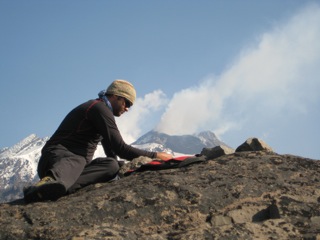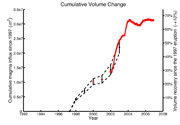The PIRE Kamchatka project is funded by the NSF Office of International Science and Engineering, under the Partnerships in Research and Education program. The scientific goal of the project is to understand more about how volcanoes respond to the unlaoding that results from large edifice collapses by comparing the behavior and evolution of Mt. St. Helens with Bezymianny and Shiveluch in Kamchatka. The educational goals of the project are to introduce US students to international collaborative research, to help build an international scientific community interested in North Pacific volcanoes, and to help US students become more integrated into that community.

| University of Miami graduate student Scott Baker sets up a GPS receiver at a campaign GPS site near Bezymianny volcano. |
In addition to students from UAF, we have involved 3-5 students each year from Universities around the country. These students participate in the fieldwork and are supposed to use data from this work in their thesis projects. This approach has worked quite well overall; at least 4 students at other universities have made data from this project a major part of their thesis, or have chosen to follow research directions based mainly on their experiences with our project. Most other students have made use of data from this project to some degree. We have also had students from other countries join us in the field using their own funding, making the project a truly multinational experience.

| UAF graduate student Taryn Lopez makes gas measurements at Bezymianny volcano, using a portable spectrometer. |
All three volcanoes experienced large lateral blasts and flank collapses that removed a large part of the pre-blast edifice, Bezymianny in 1956, Shiveluch in 1964, and St. Helens in 1980. Bezymianny is part of the Klyuchevskoi group of volcanoes, located near the northern end of the great central valley of Kamchatka. Shiveluch is located to the north of the Klyuchevskoi group. Overall, these volcanoes have had a very high magma productivity rate, although Bezymianny had been dormant for centuries before its blast. Since the blast, each of these volcanoes has erupted magma at a very high rate, Bezymianny, for example, has nearly rebuilt its edifice.
Our project has supported geological and geophysical fieldwork at Bezymianny, geological fieldwork at Shiveluch, and work comparing these volcanoes to St. Helens. We have conducted annual field expeditions since 2006, with further work planned for summers 2009 and 2010. We also have organized a seminar every year with Cascades Volcano Obsevatory staff to discuss the similarities and differences between the three volcanoes.
We set up 10 GPS monuments for continuous GPS measurements at Bezymianny volcano, and continuous measurements have been made at 8 of these sites. The other two are occupied during our expeditions. We also have 4 additional campaign GPS sites that we have surveyed repeatedly.

Bezymianny GPS network average velocities, relative to Klyuchi (the closest continuous
site off the volcano). Red bars are vertical motions, on the same scale
Other information on the project is available on the web:
- Our main project page.
- We also have a project page at Google sites.
Bezymianny erupts roughly twice a year. One surprising result has been that the deformation associated with these eruptions has been quite small. However, we have observed significant steady deformation. The pattern, however, has been puzzling. We observe substantial subsidence aross the region, possibly concentrated in a roughly north-south line that parallels the orientation of the Klyuchevskoi group and Tolbachik to the south. To solidiy this conclusion, it is vital that we reoccupy a continuous GPS site located at the eastern end of our network, which we have not been able to reach in the last couple of years due to weather and helicopter problems.
PIRE Kamchatka students (geodesy):
Gwyneth Hughes (Stanford)
Ronni Grapenthin (UAF)
Scott Baker (University of Miami)
Dr. Jeffrey T. Freymueller
Professor of Geophysics
Geophysical Institute
University of Alaska, Fairbanks
Fairbanks, AK 99775-7320




